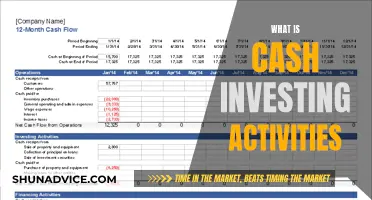
The Federal National Mortgage Association (FNMA), or Fannie Mae, is a government-sponsored enterprise that provides liquidity to the mortgage market by buying loans from banks and mortgage companies. Fannie Mae does not sell mortgages directly to consumers, but it does offer different loan products and provides educational services to consumers.
Fannie Mae has had a significant impact on the housing market since its establishment in 1938, promoting homeownership among middle- and lower-income Americans by backing long-term, fixed-rate mortgages.
This text will explore whether you should use Fannie Mae for investment loans.
What You'll Learn

Fannie Mae's role in the mortgage market
The Federal National Mortgage Association (FNMA), commonly known as Fannie Mae, is a government-sponsored enterprise (GSE) founded in 1938 by Congress during the Great Depression. As part of the New Deal, it was established to stimulate the housing market by making more mortgages available to moderate- to low-income borrowers.
Fannie Mae does not extend mortgages to borrowers. Instead, it keeps funds flowing to lenders by purchasing or guaranteeing mortgages issued by credit unions, banks, thrifts, and other financial institutions. In 2022, Fannie Mae provided $684 billion in liquidity to the mortgage market.
Fannie Mae is one of two large purchasers of mortgages in the secondary market. The other is Freddie Mac, or the Federal Home Loan Mortgage Corporation, also a GSE chartered by Congress. After purchasing mortgages on the secondary market, Fannie Mae pools them to form mortgage-backed securities (MBS). These are purchased as investments by large institutional buyers, such as insurance companies, pension funds, and investment banks.
Fannie Mae also helps to stabilise mortgage markets and protect housing during periods of turmoil in the broader financial system. It does this by supporting mortgage lending that finances affordable housing, reducing the cost of borrowing.
Fannie Mae's mortgage-backed securities are purchased by institutions, and it guarantees payments of principal and interest on its MBSs. It also has a retained portfolio, which invests in its own and other institutions' mortgage-backed securities. To fund this, Fannie Mae issues debt, called agency debt.
Fannie Mae mortgages are the most common type of mortgage for buying or refinancing a home, and knowing Fannie Mae guidelines improves your odds of getting a conventional mortgage approval.
Computing Investment Cash Flows: A Guide to Statement Analysis
You may want to see also

Fannie Mae's loan products
Fannie Mae, the Federal National Mortgage Association (FNMA), is a government-sponsored enterprise (GSE) that was founded in 1938 by Congress during the Great Depression. It aims to stimulate the housing market by making mortgages more accessible to low- and moderate-income borrowers.
Fannie Mae does not directly offer mortgages to borrowers. Instead, it purchases and guarantees mortgages through the secondary mortgage market, reducing the risks to banks and making them more willing to lend money. As one of the largest purchasers of mortgages on the secondary market, Fannie Mae creates liquidity for lenders, allowing them to underwrite or fund additional mortgages.
- HomeReady Mortgage: This product allows homeowners to secure financing and purchase a home with a low down payment. It is designed for borrowers with low to moderate incomes and a credit score below 620. Those with scores above 620 benefit from better pricing.
- 3% Down Payment: This program assists homeowners who may struggle to come up with a large down payment.
- HFA Preferred: This program helps homeowners access affordable financing through local and state Housing Finance Agencies and other lenders. Income levels for borrowers are determined by the HFA, and there are no first-time buyer requirements.
- RefiNow: This is a refinance option for low-income mortgage holders, allowing them to reduce their interest rates and monthly payments. To be eligible, homeowners must have an income at or below 80% of their area median income (AMI).
- 97% LTV Program: This program enables homebuyers to put as little as 3% down on a home, resulting in a loan-to-value ratio of 97%. It is available to first-time homebuyers and those refinancing a Fannie Mae loan, provided they meet income limits and homebuyer education requirements.
- HomePath: This is a website where Fannie Mae features foreclosed properties, also known as real estate-owned (REO) properties, for resale. These properties are typically sold as-is and may require some work, but they can offer good deals for buyers.
- HFA Preferred: An affordable lending product issued in conjunction with Housing Finance Agencies (HFAs). It features flexible underwriting requirements, including LTV ratios of up to 97%, borrower income limits set by the HFA, and reduced mortgage insurance coverage for those at or below 80% of the area median income.
Understanding the Cash Flow Statement: Operations, Investments, and Financing
You may want to see also

The impact of Fannie Mae on the housing market
The Federal National Mortgage Association (FNMA), or Fannie Mae, is a government-sponsored enterprise (GSE) founded in 1938 by Congress during the Great Depression. Its purpose is to stimulate the housing market and make mortgages more accessible to low- and moderate-income borrowers.
Fannie Mae does not directly offer mortgages to borrowers. Instead, it purchases and guarantees mortgages through the secondary mortgage market, reducing the risk to banks and making them more willing to loan money. This, in turn, creates liquidity in the market by allowing lenders to underwrite or fund additional mortgages. In 2022, Fannie Mae provided $684 billion in liquidity to the mortgage market, helping 2.6 million households buy, refinance, or rent homes.
Fannie Mae's role in the housing market is significant. It has helped create the modern system of long-term, fixed-rate mortgages that can be refinanced at any point. By providing financial security to lenders, it has made homeownership more affordable and accessible.
Fannie Mae also sets guidelines for lenders to follow when determining a borrower's ability to repay a loan. These guidelines include factors such as down payment, credit score, credit history, debt-to-income ratio, cash reserves, income, and property type.
Fannie Mae's impact on the housing market can be seen in its ability to provide liquidity, stimulate homeownership, and set standards for the industry. Its role has been particularly crucial during challenging economic periods, such as the Great Depression and the 2008 financial crisis.
However, it is important to note that Fannie Mae faced significant challenges during the 2008 financial crisis and required a government bailout. This highlights the interconnectedness of the housing market and broader economic trends.
Understanding Invested Assets: Does Cash Count?
You may want to see also

The benefits of using Fannie Mae for investment loans
The Federal National Mortgage Association (FNMA), better known as Fannie Mae, is a government-sponsored enterprise (GSE) founded in 1938 by Congress during the Great Depression. As part of the New Deal, it was established to stimulate the housing market by making more mortgages available to moderate- to low-income borrowers. Here are some benefits of using Fannie Mae for investment loans:
Liquidity for lenders
Fannie Mae does not directly offer mortgage loans to borrowers. Instead, it purchases mortgages from lenders and packages them into mortgage-backed securities, which are then sold to institutional investors. This process frees up cash for lenders, allowing them to offer more loans to borrowers. In 2022, Fannie Mae provided $684 billion in liquidity to the mortgage market.
Long-term, fixed-rate mortgages
Before the creation of Fannie Mae, home loans typically had to be repaid within a short period, sometimes as little as five years, with large balloon payments at the end. Fannie Mae's involvement in the market enabled the emergence of long-term, fixed-rate mortgages, which are more affordable for borrowers.
Lower interest rates
Mortgages purchased and guaranteed by Fannie Mae are known as conforming loans. These loans often have lower interest rates compared to non-conforming or jumbo loans that are not backed by Fannie Mae. This makes it more affordable for borrowers to take out loans.
Broader access to credit
Fannie Mae's role in the mortgage market makes it easier for lenders to extend credit to borrowers. This increases the availability of credit, particularly for low- and moderate-income individuals and families, who may otherwise struggle to obtain financing for home purchases.
Support for investment properties
Fannie Mae loans can be used for the purchase of investment properties, in addition to primary and secondary residences. This provides flexibility for borrowers who are looking to invest in real estate. However, it is important to note that the down payment requirements for investment properties are typically higher, at a minimum of 20%.
No Cash for Investments? Here's Why and What to Do
You may want to see also

The pros and cons of using Fannie Mae for investment loans
Fannie Mae, or the Federal National Mortgage Association (FNMA), is a government-sponsored enterprise that buys and securitises mortgages to ensure a steady supply of money for home loans. It was created in 1938 to increase the availability of affordable housing and stimulate the housing market.
Pros
- Qualification guidelines designed to help more people buy homes: Fannie Mae's qualification guidelines are designed to help more people buy homes, even if they don't have a great credit score.
- Low down payment loan options: You may only need to put 3% down with a Fannie Mae loan, making it easier to buy a home.
- Acceptance of non-traditional income sources: Fannie Mae accepts non-traditional income sources like alimony, long-term disability income, and public assistance.
- Different types of loans to meet your needs: Fannie Mae offers a range of different loans, including the HomeStyle loan for buying a house that needs repairs, and the HomeReady loan for borrowers with low to moderate incomes.
- Mortgage insurance can be cancelled: With a Fannie Mae loan, you can cancel your mortgage insurance once you reach 20% equity in your home, which isn't the case with all home loans.
Cons
- Possible mortgage insurance: If you can't afford a 20% down payment, you'll need to pay for mortgage insurance, which is an extra monthly cost.
- Possible income limits: There are income limits in place for certain types of loans, like the HomeReady loan, which is designed for borrowers with low to moderate incomes.
- Not available from all mortgage lenders: Not all mortgage lenders offer Fannie Mae loans, so you may need to go with a different lender.
- Homeownership class required: Some Fannie Mae loans, like the HomeReady mortgage, require first-time homebuyers to take a homeownership class.
- Stricter property requirements: Fannie Mae has specific criteria about the types of properties you can purchase, which may limit your options.
- More complex approval process: The approval process for a Fannie Mae loan might be more complicated and longer than with other types of loans.
- Private Mortgage Insurance (PMI) for low down payment: If you can't afford a 20% down payment, you'll need to pay for PMI, increasing the overall cost of your loan until you reach 20% equity in your home.
A Beginner's Guide to Sofi Automated Investing
You may want to see also
Frequently asked questions
Fannie Mae, officially the Federal National Mortgage Association (FNMA), is a government-sponsored enterprise that maintains liquidity in the mortgage market by buying loans from banks and mortgage companies.
The pros of a Fannie Mae mortgage are that you won't pay mortgage insurance with a 20% down payment, and you can buy a primary, second or investment home. The cons are that you'll need higher credit scores to qualify, and you'll have to wait longer to qualify after a bankruptcy or foreclosure.
The mortgages that Fannie Mae purchases and guarantees must meet strict criteria. The limit, set by the FHFA, for a conventional loan for a single-family home in 2023 is $726,200 for most areas and $1,089,300 for high-cost areas.
The Federal Housing Finance Agency (FHFA) announced some changes that affected mortgage loan requirements that determine the interest rate you’re given for a Fannie Mae mortgage. Credit score, DTI ratio, down payment, and property type requirements were updated in 2023.
Borrowers complete a Uniform Residential Loan Application and gather and provide financial information and documentation. This includes employment and gross income and statements, such as a W-2 or 1099.







